“Ahead lunges are a favourite for his or her effectiveness in concentrating on the quads and fascinating the glutes. Nevertheless, they’re not with out drawbacks,” says Joey Thurman, CPT, licensed private coach, writer, and founding father of Enjoyable Health Bros. “Some people expertise knee ache, dislike the train, or battle with sustaining correct kind, which might diminish the effectiveness and enhance the chance of damage.”
We talked to health consultants who shared their favourite lunge alternate options to strengthen and tone your legs.
Advantages of lunges
Along with cardio train, it is necessary to include power workouts, just like the lunge, into your routine not less than twice per week. Lunges are a favourite train of trainers for a number of causes.
1. They strengthen your decrease physique
This one transfer works your hip, knee, and ankle muscle tissue. Particularly, the lunge strengthens your gluteus maximus, hamstrings, quads, and calves.
Improved power in your legs makes on a regular basis actions, akin to taking the steps, strolling, or bending down, that a lot simpler. It additionally interprets into sports activities actions, like improved operating pace, based on the Nationwide Energy and Conditioning Affiliation (NSCA).
2. They construct core power
The lunge strengthens greater than your legs. Since you are in a staggered-stance place with the lunge, your core muscle tissue kick in to assist stabilize you to forestall you from shedding your stability. A robust core has many advantages, together with serving to to forestall again ache and enhancing posture.
3. They enhance stability
The staggered-stance place of the lunge challenges your physique to work all these muscle tissue that assist you keep balanced, like your core muscle tissue. That is particularly necessary as you become older to assist forestall falls.
Drawbacks of lunges
For some individuals, lunges will not be the very best train—or the train must be modified. Let’s have a look at among the cons of lunges.
1. They solely work your physique in a single route
“Lunges is usually a nice train selection, however one main downside is that you’re solely transferring within the sagittal airplane—or solely transferring ahead or backward,” says Grayson Wickham, DPT, CSCS, bodily therapist, licensed power and conditioning specialist, and founding father of Motion Vault. “Most individuals are already performing loads of actions going straight ahead—suppose: strolling, operating, and so forth.—and do not carry out sufficient side-to-side and rotational actions.”
This could result in mobility and stability points in your rotator muscle tissue and the muscle tissue which are positioned on the aspect of your hips, Wickham explains. These muscle tissue embody your gluteus medius and small hip inner and exterior rotator muscle tissue.
“Having poor mobility and stability in these muscle tissue may cause compensations in your knee, which might ultimately result in knee joint put on and tear, and ultimately knee ache and damage,” he says.
2. They require flexibility
“Lunges can be difficult in case you have tight hip flexors or poor mobility in your large toe,” Wickham says. “When you may have tight muscle tissue in these areas, it will probably result in knee or large toe ache.”
When you discover you’ll be able to’t do the lunge with correct kind or you may have knee ache whereas doing it, strive doing hip flexor stretches to enhance your flexibility.
When you’ve had a toe damage and have a diminished vary of movement, it’s possible you’ll must keep away from the lunge altogether to keep away from injuring your knee.
3. They require stability
“Lunges additionally require extra stability and stability, as your ft are usually not aspect by aspect and are one in entrance of the opposite, which gives a slender base of assist,” Wickham says.
When you really feel like you’ll be able to’t safely do a lunge, you must guarantee you may have a secure floor to carry on to, or don’t train till your stability improves. Workout routines to strengthen your core also can assist.
4. They’ll trigger knee ache
When you aren’t doing the train with correct kind, lunges may cause knee ache and accidents. If it’s a kind error, like having your ft too shut collectively and never stepping out far sufficient, then switching up your kind may help.
In case you have accidents or lack of mobility which are stopping you from doing the lunge appropriately, you must make modifications or do different strengthening workouts.
“Lunges is usually a nice train selection, however one main downside is that you’re solely transferring within the sagittal airplane—or solely transferring ahead or backward.” —Grayson Wickham, DPT, CSCS
Finest lunge alternate options
“For these looking for alternate options to ahead lunges, specializing in workouts that promote knee flexion will be helpful,” Thurman says.
Listed here are 5 lunge alternate options so as to add to your train routine.
1. Squat
“Performing a customary squat is an effective lunge different as a result of each of your ft are on the bottom aspect by aspect, which is an effective different in case you have tight hip flexors or a good large toe joint,” Wickham says. It additionally strengthens your glutes, hamstrings, and quads—much like the lunge.
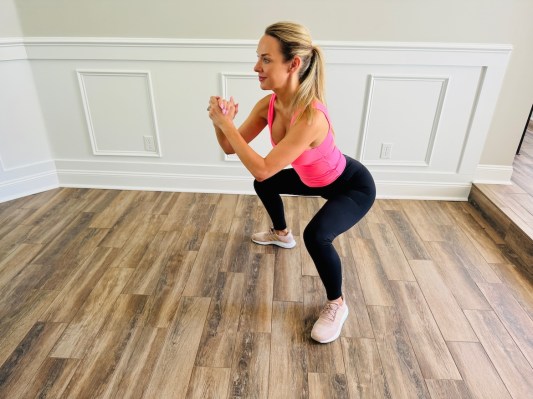
- Stand along with your ft shoulder-width aside, shoulders again, your toes barely turned out, and your palms clasped in entrance of your chest.
- Bend your knees as you push your hips again and shift your weight onto your heels as you squat down.
- Preserve your chest up and your core tight.
- Squat down till your knees are parallel to the bottom—or cease earlier than that in case you have ache or can’t keep correct kind.
- Squeeze your glutes and push by means of your heels to straighten your legs and return to a standing place.
- Carry out 1 to three units of 12 to fifteen reps.
2. Cossack squat
“Performing Cossack squats are a superb different as a result of they emphasize motion in a frontal airplane of movement—aka aspect to aspect—in addition to stretch out your interior thigh adductor muscle tissue,” Wickham says.
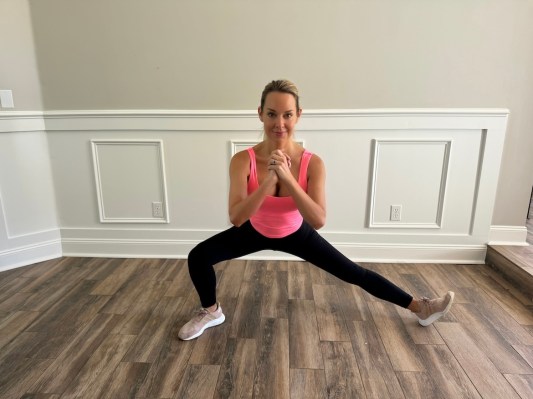
- Stand along with your ft wider than shoulder-width aside along with your toes pointed barely out and your palms clasped in entrance of your chest.
- Shift your weight to your proper aspect, bending your proper knee as you squat down on that aspect.
- Your left leg will keep straight, as you level your left toes straight up along with your left heel on the bottom.
- Preserve your torso straight up. Squat down so far as you’ll be able to comfortably go.
- Push again up along with your proper leg to the beginning place.
- Repeat on the opposite aspect.
- Carry out 1 to 2 units of 5 to 10 reps on both sides.
3. Single-leg cut up squat
“Single-leg cut up squats are a superb different in case you have tight big-toe joints that result in foot ache whereas performing lunges,” Wickham says.
This train, which can be referred to as a Bulgarian cut up squat, additionally works your core and stability, much like the lunge. Begin out with simply your physique weight, after which progress to holding weights.
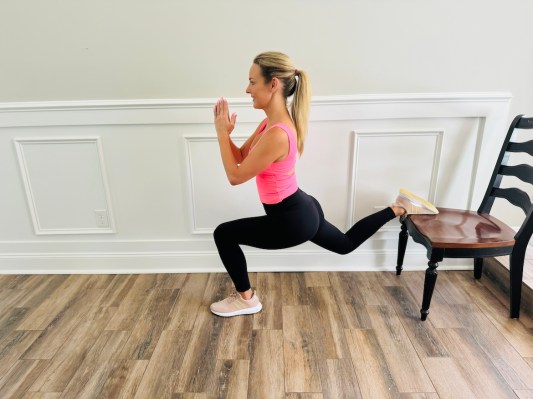
- Stand a number of ft in entrance of a bench, field or chair, dealing with away from it. The bench, field, or chair must be at knee-level and about 2 ft behind you.
- Attain your proper foot again and place the highest of your foot flat on the floor. Your proper foot must be far sufficient in entrance that whenever you bend your knee, your knee doesn’t come over your toes. It’s possible you’ll must hop that foot ahead till it is sufficient in entrance.
- Lean your torso ahead barely and bend your entrance knee to sink your hips towards the ground as little as you’ll be able to comfortably go.
- Your front-leg shin must be vertical or near it, whereas your again knee ought to level down towards the ground. If both leg is misplaced, transfer your entrance foot ahead or backward till you’ve discovered the best positioning.
- Push by means of the center of your entrance foot to return to standing.
- Repeat.
- Carry out 1 to 2 units of 10 to 12 reps on every leg.
4. Step-up
“Steps-ups on a field are a superb different, as these work related muscle tissue, however demand much less mobility and stability,” Wickham says.
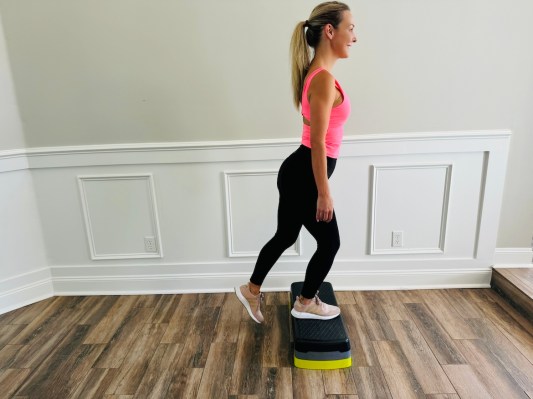
- Stand in entrance of a bench or step along with your arms down by your sides. The taller the step, the extra demand in your muscle tissue.
- Step up along with your proper foot, pushing up till your proper leg is straight. Attempt to maintain your left foot elevated and off the step.
- Pause on the high, then slowly decrease your self down.
- Carry out 1 to three units of 12 to fifteen reps on both sides.
5. Reverse lunge
“In your lunge lovers who need to maintain them of their arsenal, strive incorporating reverse lunges,” Thurman says. “This lunge variation tends to contain extra glute activation, poses a decrease danger of damage, and customarily feels smoother for most individuals [compared to forward lunges].”
As a bonus, reverse lunges put much less stress in your knee joint in comparison with ahead lunges, based on a small 2021 research in Bodily Remedy in Sport.
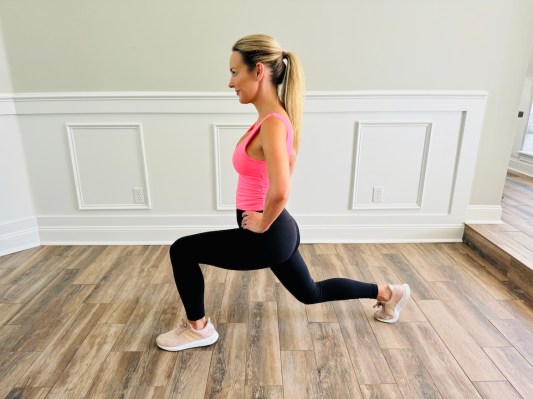
- Begin by standing along with your ft hip-width aside and your palms in your hips.
- Step again along with your proper foot, touchdown on the ball of your foot.
- Bend your proper knee in a lunge place, decreasing your self down till each knees are at a 90-degree angle (or as little as you’ll be able to comfortably go).
- Preserve your trunk upright and your hips dealing with ahead.
- Push off along with your proper foot to step your proper leg again to the beginning place.
- Carry out 1 to three units of 12 to fifteen reps on every leg.
Security suggestions
“In case you have ache whereas performing lunges, first attempt to lower the space that you just’re stepping whereas performing your lunge, Wickham says. “When you nonetheless have ache whereas performing lunges, proper after the train, or inside 24 hours afterward, you must select a unique leg train as an alternative of lunges.”
When you’ve had a current damage or have one other medical situation, discuss to your physician earlier than beginning an train program. In case you have stability points, be sure you have a secure floor to carry on to and somebody helping you.
FAQ
1. What machine is an effective substitute for lunges?
“I’m not a giant fan of machines for probably the most half as they restrict your diploma of freedom when performing a motion—and so they lower the demand of the stabilizing muscle tissue wanted,” Wickham says. “Typically, you simply want to enhance your joint mobility and stability to be able to carry out workouts with free weights.”
Within the case that you just wish to use a machine, although, leg presses or hack squats is usually a good substitute, Wickham says.
Thurman agrees that machine leg presses, in addition to leg extensions, are a superb substitute.
“Choices like machine leg extensions isolate the quads with out the complexity of lunges,” Thurman says.
2. How do you do lunges in case you have dangerous knees?
“Performing lunges with much less distance between your back and front foot will lower the problem and stability calls for,” Wickham says.
Preserve the vary of movement in your pain-free vary.
“You may as well make them simpler by performing them in a restricted vary of movement, akin to solely permitting your knee to descend a part of the way in which versus your knee transferring all the way in which right down to the bottom,” he says.
You may as well carry out a body weight lunge whereas holding on to one thing for assist akin to a wall, chair, or field, Wickham says.
Along with reverse lunges, Thurman says strolling lunges are an alternative choice.
“This variation promotes ahead motion, distributing weight extra evenly and doubtlessly mitigating the knee and kind points related to stationary ahead lunges,” he says.
3. How can I work my legs with out lunges?
Along with the workouts above, actions like strolling, operating, and biking will all strengthen your leg muscle tissue. You may run steps and incorporate hills to additional strengthen your legs.
Leaping rope and field jumps will strengthen your legs and provide you with an extra cardio enhance as nicely. Exercises akin to Pilates and yoga will strengthen your legs, work your core, and enhance your general flexibility.
Nicely+Good articles reference scientific, dependable, current, strong research to again up the data we share. You may belief us alongside your wellness journey.
-
Goulette D, Griffith P, Schiller M, Rutherford D, Kernozek TW. Patellofemoral joint loading throughout the ahead and backward lunge. Phys Ther Sport. 2021 Jan;47:178-184. doi: 10.1016/j.ptsp.2020.12.001. Epub 2020 Dec 4. PMID: 33310585.

